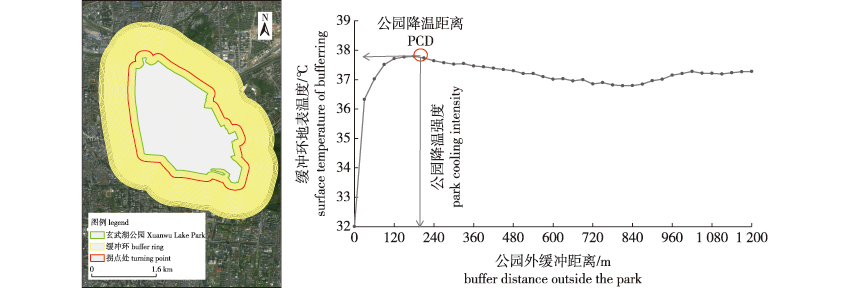 PDF(4550 KB)
PDF(4550 KB)


Research on the cooling effect of parks in Nanjing based on multi-source data
ZHU Yunfeng, WANG Hong, QIN Shuhong, YANG Yi, WANG Yicong
Journal of Nanjing Forestry University (Natural Sciences Edition) ›› 2024, Vol. 48 ›› Issue (3) : 285-294.
 PDF(4550 KB)
PDF(4550 KB)
 PDF(4550 KB)
PDF(4550 KB)
Research on the cooling effect of parks in Nanjing based on multi-source data
【Objective】 The study aimed to quantify the cooling effect of parks using the inflection point method, and to determine the area and perimeter thresholds of parks with an efficient cooling effect. The internal and external characteristics of urban parks and their influence on the cooling effect was analyzed based on multi-source data. 【Method】 The radiative transfer method was used to retrieve the surface temperature from Landsat-8 remote sensing images on September 13, 2019, and the land cover was classified using the random forest method based on Gaofen-2 remote sensing images. The area of interest (AOI) on the Baidu map was used to determine the boundaries of 83 parks. The inflection point method was used to determine the cooling intensity and cooling distances of parks. The relationship between the cooling effect of parks and three influencing factors, namely, features of the landscape, internal park environment, and external park environment, was determined by correlation analysis and the SHAP analysis. 【Result】 The cooling threshold of parks encompassed an area of 18-19 hm2 with a perimeter of about 1.9-2.0 km. The results of feature indicator analysis revealed that the cooling effect of parks can be reduced by a high proportion of construction land and a high patch density within the parks, but enhanced by a high proportion of waterbodies and green spaces. Parks with a smaller area-weighted perimeter ratio had a higher cooling efficiency. The structural parameters and physiological characteristics of the vegetation had a significant influence on the cooling effect of parks. The cooling distances of parks increased was higher in the proportion of vegetation with better growth and greater canopy height. Soil moisture also played a crucial role in the cooling effect of parks. However, the cooling effect was weakened by the presence of surrounding buildings of greater height and a higher road density outside the parks. 【Conclusion】 The cooling effect of parks is influenced by internal and external landscape features and environmental characteristics. The cooling effect of parks can be enhanced by improving the integrity of the landscape, ensuring the distribution of green spaces and waterbodies, and cultivating high-quality vegetation, to mitigater the urban heat island effect.

city parks / urban heat island / cold island effect / multi-source data / inflection point method / SHAP analysis / Nanjing City
| [1] |
|
| [2] |
胡欣雨. 南阳市主城区热岛效应及绿地降温作用研究[D]. 福州: 福建农林大学, 2022.
|
| [3] |
|
| [4] |
倪黎, 沈守云, 黄培森. 园林绿化对降低城市热岛效应的作用[J]. 中南林业科技大学学报, 2007, 27(2):36-43.
|
| [5] |
|
| [6] |
|
| [7] |
赵海月, 胡淼, 朱建宁, 等. 高密度中心城区蓝绿空间冷岛效应及其影响因素:以北京五环路以内地区为例[J]. 生态学报, 2023, 43(12):4904-4919.
|
| [8] |
|
| [9] |
|
| [10] |
|
| [11] |
|
| [12] |
|
| [13] |
|
| [14] |
|
| [15] |
|
| [16] |
|
| [17] |
|
| [18] |
孙燕, 濮梅娟, 张备, 等. 南京夏季高温日数异常的分析[J]. 气象科学, 2010, 30(2):279-284.
|
| [19] |
|
| [20] |
|
| [21] |
|
| [22] |
赵芮, 申鑫杰, 田国行, 等. 郑州市公园绿地景观特征对公园冷岛效应的影响[J]. 生态学报, 2020, 40(9):2886-2894.
|
| [23] |
|
| [24] |
江海英, 柴琳娜, 贾坤, 等. 联合PROSAIL模型和植被水分指数的低矮植被含水量估算[J]. 遥感学报, 2021, 25(4):1025-1036.
|
| [25] |
|
| [26] |
|
| [27] |
韩煜娜, 左德鹏, 王国庆, 等. 变化环境下青藏高原陆地水储量演变格局及归因[J]. 水资源保护, 2023, 39(2):199-207,214.
|
| [28] |
王新军, 冯星莹, 陈凯莉, 等. 城市公园的冷岛效应研究:以常州市为例[J]. 中国环境科学, 2021, 41(9):4245-4252.
|
| [29] |
|
| [30] |
姚春生, 张增祥, 汪潇. 使用温度植被干旱指数法(TVDI)反演新疆土壤湿度[J]. 遥感技术与应用, 2004, 19(6):473-478.
|
| [31] |
|
/
| 〈 |
|
〉 |